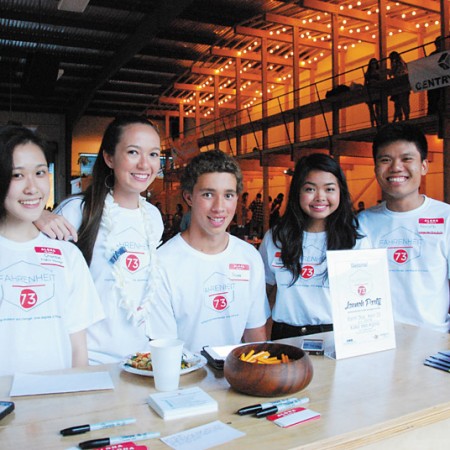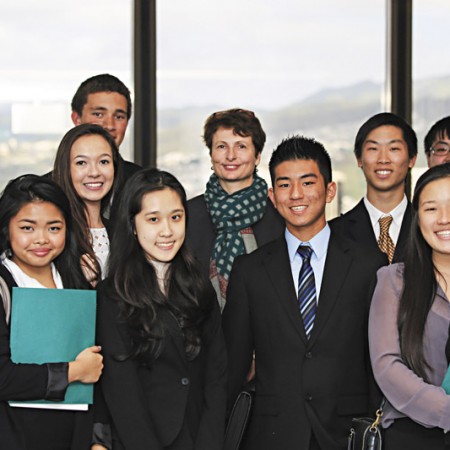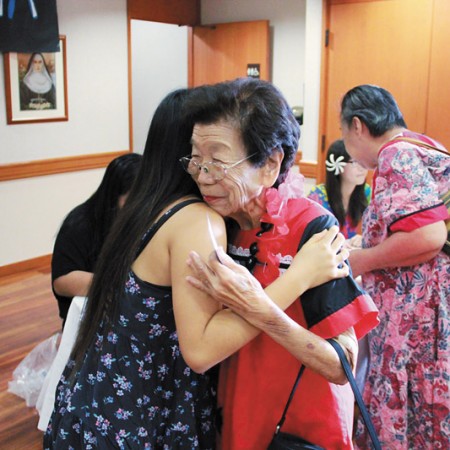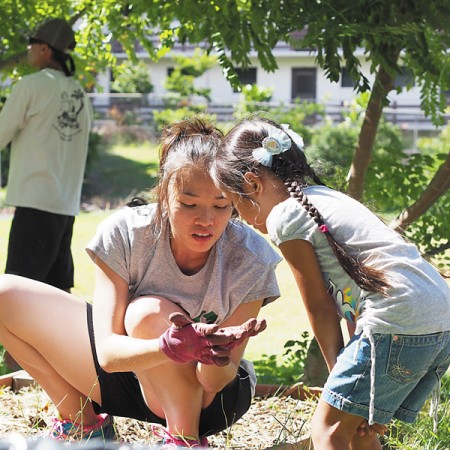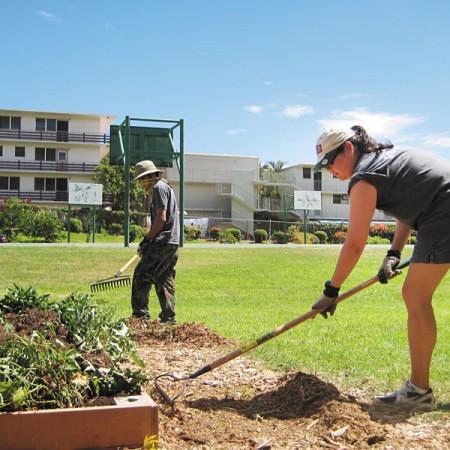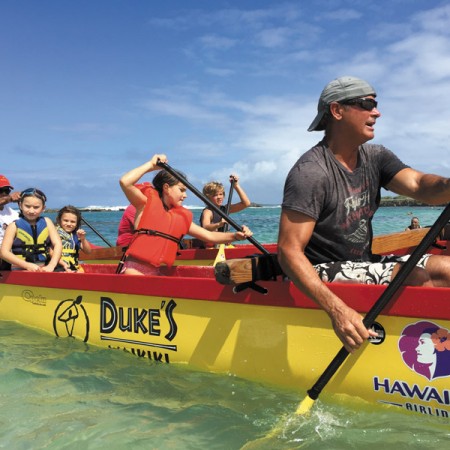Saints & Sinners
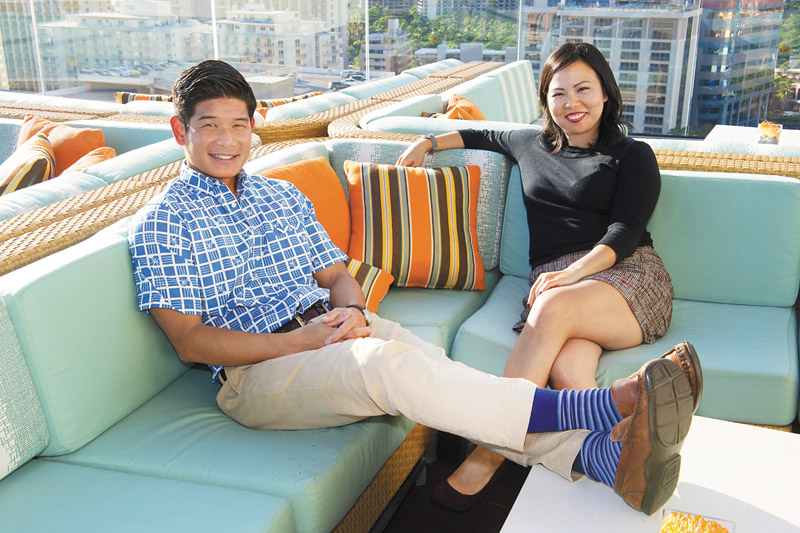
This year’s GIFT Foundation event co-chairs Robert Kurisu and Morgan Kaya relax at SKY Waikiki, where the Saints and Sinners party was held
NATHALIE WALKER PHOTO
Last Friday, hundreds of revelers donned costumes with the theme “Saints and Sinners” for a party at SKY Waikiki that was probably a little more raucous than pious. But what they were there to celebrate was the saintly activities of three local nonprofit organizations: Center for Tomorrow’s Leaders, which offers leadership training for teens; Hands In Helping Out, which connects volunteers with groups that need their services; and Na Kama Kai, which provides ocean education to youths.
The three groups are this year’s beneficiaries of GIFT (Giving Inspiration for Tomorrow) Foundation of Hawaii, which combines partying with philanthropy to raise money for charitable organizations through their annual soirée. Comprised of young professionals, GIFT Foundation has raised millions of dollars for dozens of groups since its inception in 2003.
“We always like to bring awareness to these smaller organizations that may not be top of mind or might not be known to a lot of people,” explains Morgan Kaya, a human resources consultant who co-chaired this year’s event alongside commercial real estate executive Robert Kurisu.
“These (organizations) were the ones that stood out the most,” Kurisu says.
Each of these groups, Kaya and Kurisu say, stands to positively impact Hawaii’s future. But each also is at a critical point in its growth — and with funding from GIFT, the groups will be able to effectively grow their organizations and ultimately achieve a wider impact.
Here’s a closer look at this year’s GIFT beneficiaries.
CENTER FOR TOMORROW’S LEADERS
As a high school student in the early 2000s, Katie Chang had a vague notion that she wanted to make a difference — but she just wasn’t sure what that would entail.
That is, until she was admitted into the Center For Tomorrow’s Leaders’ (CTL) inaugural Fellows class in 2003. The fellowship, she recalls now, helped her harness her big ideas.
“Being given the tools of leadership and communication — and the confidence to actually go out and make a difference — to me, that was incredibly empowering,” Chang says.
In 2011, after attending college on the Mainland and a stint as an adviser for Fulbright Commission in London, Chang returned home to the Islands and assumed her current role as executive director of CTL.
- A group of CTL students raised money to install air conditioning in a Campbell High classroom: (from left) Charissa Tan, Allison Saunders, Noah Faurot, Eunica Escalante and Kenneth Go LORI ANN SAUNDERS PHOTO
- CTL Fellows with guest speaker Bettina Mehnert, president and CEO of Architects Hawaii, after a mentoring session BAD MOON SALOON / ARCHITECTS HAWAII PHOTO
- CTL student Anna Kim worked with seniors in an assisted-living home for her student-led project MARK BUENAFE PHOTO
The goal, as Chang explains it, is to “engage, equip and empower Hawaii’s future leaders to start making a difference now.”
“Our young people have big potential to lead and we shouldn’t have to wait. We can start teaching them and empowering them to start making a difference now,” Chang says.
Its Fellows program provides 20 select juniors and seniors in public and private schools with leadership coaching and opportunities to meet local executives, government officials and other leaders. In recent years, CTL also added a Schools program, which offers for-credit leadership development courses in direct partnership with public high schools. Each of the programs also entails student-led projects in which students identify a need within their school or larger community and try to tackle it. Projects to come out of CTL so far have included installing air conditioning in classrooms, leading anti-bullying initiatives and lobbying for affordable housing.
Both the Fellows and the Schools programs are designed to provide students with opportunities to hone practical skills.
For Kaiser High School senior Sierra Doi, who was a CTL Fellow in her junior year, it improved her public speaking.
“I got way better. I was really shy before,” says Doi, who plans to study architecture in college next year. She adds that the fellowship helped her become especially adept at communicating with professionals — something she got ample practice with while pitching her housing access project to local businesspeople.
- HIHO volunteer Tiffany Kugiya shares a teachable moment with Thalia Grace Hoapili while working with Kokua Hawaii Foundation PHOTOS COURTESY HIHO
- HIHO volunteers Marcus Hoapili (left) and Nancy Kishi-Char tend to garden beds at Kokua Hawaii Foundation’s ‘AINA In Schools program at Waikiki Elementary
- Na Kama Kai offers monthly ocean clinics at a rotating set of beaches across the island PHOTO COURTESY NA KAMA KAI
Currently, CTL is in the process of expanding its Schools program in order to reach more students across more campuses — and that is what GIFT’s funding will go toward.
“The idea is to find … students who may not have a leadership title or may not think they are leaders yet, but who have the potential to lead,” Chang says.
So far, CTL has trained about 500 students in the program, about 60 percent of whom have gone on to hold a formal leadership role in their school.
“We love hearing ‘I didn’t think that I could be a leader,’ and ‘I never thought I could do this, but now I know that I can,'” Chang says. “And that is incredibly exciting.”
For more information, call 681-7687 or visit centerfortomorrowsleaders.org.
HANDS IN HELPING OUT
Several years ago, Navy chief Kari Albers decided that she wanted to get more involved with the community, but she found that her experiences volunteering weren’t always so great.
“Some of (the events) were completely disorganized, or they didn’t give volunteers any direction and volunteers ended up standing around doing nothing,” Albers recalls. “Some of the places didn’t really take care of volunteers, such as making sure they had breaks, sufficient water, maybe some type of food. In some cases, it was also difficult to see what type of impact you were having on the community, to see who you were helping.”
Then she met three friends, husband and wife Ryan and Shar Leong, and Cheri Kishimoto, who had founded their own nonprofit to address those very problems. Their Hands In Helping Out (HIHO) is designed to link volunteers with community organizations to create a mutually beneficial experience — providing smoother, more accessible opportunities for the volunteers, while helping the organization communicate its mission.
The Leongs and Kishimoto first started the organization informally among their own group of volunteer friends, and over time they became liaisons between their friends and the organizations that they worked with. They launched HIHO in 2009. Since then, HIHO has worked with thousands of volunteers and partners with 17 local nonprofits that represent a broad range of causes, including Aloha Harvest, 808 Urban, HUGS, Hawaii Literacy, Special Olympics Hawaii, Kids Hurt Too, Kokua Hawaii Foundation and Hawaii Nature Center.
“We really are focused on volunteerism as a movement — we come at it from a level of everybody should be doing something positive for their community,” says Ryan, HIHO’s interim executive director.
Looking ahead, HIHO hopes to scale up its operation to provide its services at more events with more organizations. But there are limitations. Each of the HIHO founders is a volunteer themselves. They all have their own full-time jobs — Ryan as associate executive director at YMCA of Honolulu Kalihi Branch, Shar as a graphic designer, and Kishimoto as a high school math teacher.
“If there is only three of us, it comes to a point where we are limited to how many volunteers we can take on,” Ryan.
That’s where the GIFT funding comes in: It will go toward HIHO Academy, a yearlong course that trains the group’s existing volunteers to oversee others at HIHO-staffed events. With that, Ryan aims for HIHO to have up to 11 teams of volunteers in the community on any given day.
“I think we can reach more people through the academy,” says Albers, who is set to graduate from the first cohort next month. “If there were two events, the academy grads would be able to lead an event, freeing up the HIHO staff to lead another.”
“That is going to allow us to have so much more of an impact,” Ryan says.
For more information, visit hiho.org.
NA KAMA KAI
As a professional surfer, Duane DeSoto has been around the world — places like Brazil, South America and Indonesia — and his travels prompted him to reflect on just how growing up surrounded by the ocean impacted him.
“I grew up very poor, and I always thought of it as a negative thing,” DeSoto recalls. “As I was getting to see what real poverty was in some of these countries, it occurred to me that I was actually super blessed because I had the ocean, and I had uncles and aunties at Makaha Beach. I had a resource that was basically better than money.”
In order to share that passion that had been such a solace to him during his childhood, DeSoto created Na Kama Kai, which works to improve access to the ocean for keiki, through programs that teach ocean safety and conservation, as well as perpetuate cultural knowledge.
Na Kama Kai hosts Ocean Safety & Conservation Awareness Clinics held monthly at beaches across the island, offering guided ocean activities, with an emphasis on competence in the water. Plus, each clinic also features cultural activities including storytelling or shaping traditional wooden surfboards. Na Kama Kai also offers the Alaka‘i Mentorship Program, which provides more in-depth ocean education sessions for teens in partnership with the Polynesian Voyaging Society. Those in the program, in turn, volunteer at the clinics to help other keiki.
In addition to teaching kids to handle themselves in the water, Na Kama Kai programming also is a means to a larger end: instilling them with a passion for preserving the ocean.
“If we impress upon the children … and create this relationship between the children and the ocean, then when they become our leaders and they become the people who have the choices to make an impact on the water and the environment, they will make better decisions,” says DeSoto, who is a father of seven.
But DeSoto wants to do more: He wants to give all keiki baseline knowledge of ocean safety. So he’s devised a plan that will bring ocean education directly to fourth-graders in schools across the island — and if things go well, throughout the state. The program will bring educational materials and ocean professionals into classrooms to cover basic ways to be safer in the water. Ultimately, DeSoto also hopes that the program can at some point become a hands-on, in-the-ocean experience.
The GIFT funding, DeSoto says, will help him get the program off the ground.
The skills that children learn in the water are applicable on land, too.
“We’re taking keiki and really pushing their boundaries,” he says.
“If they can learn to be in the ocean and be safe and be able to navigate the ocean all the time … that translates into confidence in everything else they do in life,” he continues. “The ocean is powerful, and the ocean is deceptive — and being able to interact with the ocean, you can apply that to everything else in your life … It makes the other experiences that happen in your life easier to handle and overcome.”
For more information, call 864-9164 or visit nakamakai.org.

